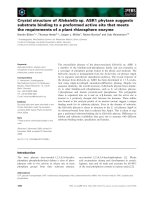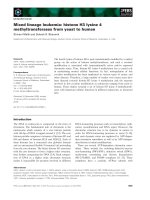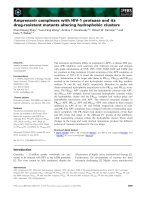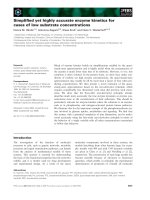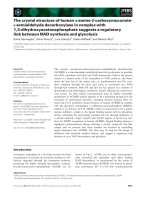Tài liệu Báo cáo khoa học: "SWAN – Scientific Writing AssistaNt A Tool for Helping Scholars to Write Reader-Friendly Manuscripts " docx
Bạn đang xem bản rút gọn của tài liệu. Xem và tải ngay bản đầy đủ của tài liệu tại đây (215.35 KB, 5 trang )
Proceedings of the 13th Conference of the European Chapter of the Association for Computational Linguistics, pages 20–24,
Avignon, France, April 23 - 27 2012.
c
2012 Association for Computational Linguistics
SWAN – Scientific Writing AssistaNt
A Tool for Helping Scholars to Write Reader-Friendly Manuscripts
/>Tomi Kinnunen
∗
Henri Leisma Monika Machunik Tuomo Kakkonen Jean-Luc Lebrun
Abstract
Difficulty of reading scholarly papers is sig-
nificantly reduced by reader-friendly writ-
ing principles. Writing reader-friendly text,
however, is challenging due to difficulty in
recognizing problems in one’s own writing.
To help scholars identify and correct poten-
tial writing problems, we introduce SWAN
(Scientific Writing AssistaNt) tool. SWAN
is a rule-based system that gives feedback
based on various quality metrics based on
years of experience from scientific writ-
ing classes including 960 scientists of var-
ious backgrounds: life sciences, engineer-
ing sciences and economics. According to
our first experiences, users have perceived
SWAN as helpful in identifying problem-
atic sections in text and increasing overall
clarity of manuscripts.
1 Introduction
A search on “tools to evaluate the quality of writ-
ing” often gets you to sites assessing only one of
the qualities of writing: its readability. Measur-
ing ease of reading is indeed useful to determine
if your writing meets the reading level of your tar-
geted reader, but with scientific writing, the sta-
tistical formulae and readability indices such as
Flesch-Kincaid lose their usefulness.
In a way, readability is subjective and depen-
dent on how familiar the reader is with the spe-
cific vocabulary and the written style. Scien-
tific papers are targeting an audience at ease with
∗
T. Kinnunen, H. Leisma, M. Machunik and T.
Kakkonen are with the School of Computing, Univer-
sity of Eastern Finland (UEF), Joensuu, Finland, e-mail:
Jean-Luc Lebrun is an inde-
pendent trainer of scientific writing and can be contacted at
a more specialized vocabulary, an audience ex-
pecting sentence-lengthening precision in writing.
The readability index would require recalibration
for such a specific audience. But the need for
readability indices is not questioned here. “Sci-
ence is often hard to read” (Gopen and Swan,
1990), even for scientists.
Science is also hard to write, and finding fault
with one’s own writing is even more challenging
since we understand ourselves perfectly, at least
most of the time. To gain objectivity scientists
turn away from silent readability indices and find
more direct help in checklists such as the peer re-
view form proposed by Bates College
1
, or scor-
ing sheets to assess the quality of a scientific pa-
per. These organise a systematic and critical walk
through each part of a paper, from its title to its
references in peer-review style. They integrate
readability criteria that far exceed those covered
by statistical lexical tools. For example, they ex-
amine how the text structure frames the contents
under headings and subheadings that are consis-
tent with the title and abstract of the paper. They
test whether or not the writer fluidly meets the ex-
pectations of the reader. Written by expert review-
ers (and readers), they represent them, their needs
and concerns, and act as their proxy. Such man-
ual tools effectively improve writing (Chuck and
Young, 2004).
Computer-assisted tools that support manual
assessment based on checklists require natural
language understanding. Due to the complexity
of language, today’s natural language processing
(NLP) techniques mostly enable computers to de-
liver shallow language understanding when the
1
/>˜
ganderso/
biology/resources/peerreview.html
20
vocabulary is large and highly specialized – as is
the case for scientific papers. Nevertheless, they
are mature enough to be embedded in tools as-
sisted by human input to increase depth of under-
standing. SWAN (ScientificWriting AssistaNt) is
such a tool (Fig. 1). It is based on metrics tested
on 960 scientists working for the research Insti-
tutes of the Agency for Science, Technology and
Research (A*STAR) in Singapore since 1997.
The evaluation metrics used in SWAN are de-
scribed in detail in a book written by the designer
of the tool (Lebrun, 2011). In general, SWAN fo-
cuses on the areas of a scientific paper that create
the first impression on the reader. Readers, and in
particular reviewers, will always read these partic-
ular sections of a paper: title, abstract, introduc-
tion, conclusion, and the headings and subhead-
ings of the paper. SWAN does not assess the over-
all quality of a scientific paper. SWAN assesses
its fluidity and cohesion, two of the attributes that
contribute to the overall quality of the paper. It
also helps identify other types of potential prob-
lems such as lack of text dynamism, overly long
sentences and judgmental words.
Figure 1: Main window of SWAN.
2 Related Work
Automatic assessment of student-authored texts is
an active area of research. Hundreds of research
publications related to this topic have been pub-
lished since Page’s (Page, 1966) pioneering work
on automatic grading of student essays. The re-
search on using NLP in support of writing scien-
tific publications has, however, gained much less
attention in the research community.
Amadeus (Aluisio et al., 2001) is perhaps the
system that is the most similar to the work out-
lined in this system demonstration. However, the
focus of the Amadeus system is mostly on non-
native speakers on English who are learning to
write scientific publications. SWAN is targeted
for more general audience of users.
Helping our own (HOO) is an initiative that
could in future spark a new interest in the re-
search on using of NLP for supporting scientific
writing (Dale and Kilgarriff, 2010). As the name
suggests, the shared task (HOO, 2011) focuses on
supporting non-native English speakers in writing
articles related specifically to NLP and computa-
tional linguistics. The focus in this initiative is
on what the authors themselves call “domain-and-
register-specific error correction”, i.e. correction
of grammatical and spelling mistakes.
Some NLP research has been devoted to apply-
ing NLP techniques to scientific articles. Paquot
and Bestgen (Paquot and Bestgen, 2009), for in-
stance, extracted keywords from research articles.
3 Metrics Used in SWAN
We outline the evaluation metrics used in SWAN.
Detailed description of the metrics is given in (Le-
brun, 2011). Rather than focusing on English
grammar or spell-checking included in most mod-
ern word processors, SWAN gives feedback on
the core elements of any scientific paper: title, ab-
stract, introduction and conclusions. In addition,
SWAN gives feedback on fluidity of writing and
paper structure.
SWAN includes two types of evaluation met-
rics, automatic and manual ones. Automatic met-
rics are solely implemented as text analysis of the
original document using NLP tools. An example
would be locating judgemental word patterns such
as suffers from or locating sentences with passive
voice. The manual metrics, in turn, require user’s
input for tasks that are difficult – if not impossible
– to automate. An example would be highlighting
title keywords that reflect the core contribution of
the paper, or highlighting in the abstract the sen-
tences that cover the relevant background.
Many of the evaluation metrics are strongly
inter-connected with each other, such as
• Checking that abstract and title are consis-
tent; for instance, frequently used abstract
keywords should also be found in the title;
21
and the title should not include keywords ab-
sent in the abstract.
• Checking that all title keywords are also
found in the paper structure (from headings
or subheadings) so that the paper structure is
self-explanatory.
An important part of paper quality metrics is as-
sessing text fluidity. By fluidity we mean the ease
with which the text can be read. This, in turn,
depends on how much the reader needs to mem-
orize about what they have read so far in order
to understand new information. This memorizing
need is greatly reduced if consecutive sentences
do not contain rapid change in topic. The aim of
the text fluidity module is to detect possible topic
discontinuities within and across paragraphs, and
to suggest ways of improving these parts, for ex-
ample, by rearranging the sentences. The sugges-
tions, while already useful, will improve in future
versions of the tool with a better understanding
of word meanings thanks to WordNet and lexical
semantics techniques.
Fluidity evaluation is difficult to fully auto-
mate. Manual fluidity evaluation relies on the
reader’s understanding of the text. It is therefore
superior to the automatic evaluation which relies
on a set of heuristics that endeavor to identify text
fluidity based on the concepts of topic and stress
developed in (Gopen, 2004). These heuristics re-
quire the analysis of the sentence for which the
Stanford parser is used. These heuristics are per-
fectible, but they already allow the identification
of sentences disrupting text fluidity.More fluidity
problems would be revealed through the manual
fluidity evaluation.
Simply put, here topic refers to the main fo-
cus of the sentence (e.g. the subject of the main
clause) while stress stands for the secondary sen-
tence focus, which often becomes one of the fol-
lowing sentences’ topic. SWAN compares the po-
sition of topic and stress across consecutive sen-
tences, as well as their position inside the sentence
(i.e. among its subclauses). SWAN assigns each
sentence to one of four possible fluidity classes:
1. Fluid: the sentence is maintaining connec-
tion with the previous sentences.
2. Inverted topic: the sentence is connected
to a previous sentence, but that connection
only becomes apparent at the very end of
the sentence (“The cropping should preserve
all critical points. Images of the same size
should also be kept by the cropping”).
3. Out-of-sync: the sentence is connected to a
previous one, but there are disconnected sen-
tences in between the connected sentences
(“The cropping should preserve all critical
points. The face features should be normal-
ized. The cropping should also preserve all
critical points”).
4. Disconnected: the sentence is not connected
to any of the previous sentences or there are
too many sentences in between.
The tool also alerts the writer when transition
words such as in addition, on the other hand,
or even the familiar however are used. Even
though these expressions are effective when cor-
rectly used, they often betray the lack of a log-
ical or semantic connection between consecutive
sentences (“The cropping should preserve all crit-
ical points. However, the face features should be
normalized”). SWAN displays all the sentences
which could potentially break the fluidity (Fig. 2)
and suggests ways of rewriting them.
Figure 2: Fluidity evaluation result in SWAN.
4 The SWAN Tool
4.1 Inputs and outputs
SWAN operates on two possible evaluation
modes: simple and full. In simple evaluation
mode, the input to the tool are the title, abstract,
introduction and conclusions of a manuscript.
These sections can be copy-pasted as plain text
to the input fields.
In full evaluation mode, which generally pro-
vides more feedback, the user provides a full pa-
per as an input. This includes semi-automatic
import of the manuscript from certain standard
22
document formats such as TeX, MS Office and
OpenOffice, as well as semi-automatic structure
detection of the manuscript. For the well-known
Adobe’s portable document format (PDF) we use
state-of-the-art freely available PdfBox extractor
2
.
Unfortunately, PDF format is originally designed
for layout and printing and not for structured text
interchange. Most of the time, simple copy &
paste from a source document to the simple eval-
uation fields is sufficient.
When the text sections have been input to the
tool, clicking the Evaluate button will trigger the
evaluation process. This has been observed to
complete, at most, in a minute or two on a mod-
ern laptop. The evaluation metrics in the tool are
straight-forward, most of the processing time is
spent in the NLP tools. After the evaluation is
complete, the results are shown to the user.
SWAN provides constructive feedback from
the evaluated sections of your paper. The tool also
highlights problematic words or sentences in the
manuscript text and generates graphs of sentence
features (see Fig. 2). The results can be saved and
reloaded to the tool or exported to html format
for sharing. The feedback includes tips on how
to maintain authoritativeness and how to convince
the scientist reader. Use of powerful and precise
sentences is emphasized together with strategical
and logical placement of key information.
In addition to these two main evaluation modes,
the tool also includes a manual fluidity assessment
exercise where the writer goes through a given
text passage, sentence by sentence, to see whether
the next sentence can be predicted from the previ-
ous sentences.
4.2 Implementation and External Libraries
The tool is a desktop application written in Java.
It uses external libraries for natural language pro-
cessing from Stanford, namely Stanford POS Tag-
ger (Toutanova et al., 2003) and Stanford Parser
(Klein and Manning, 2003). This is one of the
most accurate and robust parsers available and im-
plemented in Java, as is the rest of our system.
Other external libraries include Apache Tika
3
,
which we use in extracting textual content from
files. JFreeChart
4
is used in generating graphs
2
/>3
/>4
/>and XStream
5
in saving and loading inputs and
results.
5 Initial User Experiences of SWAN
Since its release in June 2011, the tool has
been used in scientific writing classes in doc-
toral schools in France, Finland, and Singapore,
as well as in 16 research institutes from A*STAR
(Agency for Science Technology and Research).
Participants to the classes routinely enter into
SWAN either parts, or the whole paper they wish
to immediately evaluate. SWAN is designed to
work on multiple platforms and it relies com-
pletely on freely available tools. The feedback
given by the participants after the course reveals
the following benefits of using SWAN:
1. Identification and removal of the inconsis-
tencies that make clear identification of the
scientific contribution of the paper difficult.
2. Applicability of the tool across vast domains
of research (life sciences, engineering sci-
ences, and even economics).
3. Increased clarity of expression through the
identification of the text fluidity problems.
4. Enhanced paper structure leading to a more
readable paper overall.
5. More authoritative, more direct and more ac-
tive writing style.
Novice writers already appreciate SWAN’s
functionalityand even senior writers, although ev-
idence remains anecdotal. At this early stage,
SWAN’s capabilities are narrow in scope.We con-
tinue to enhance the existing evaluation metrics.
And we are eager to include a new and already
tested metric that reveals problems in how figures
are used.
Acknowledgments
This works of T. Kinnunen and T. Kakkonen were supported
by the Academy of Finland. The authors would like to thank
Arttu Viljakainen, Teemu Turunen and Zhengzhe Wu in im-
plementing various parts of SWAN.
References
[Aluisio et al.2001] S.M. Aluisio, I. Barcelos, J. Sam-
paio, and O.N. Oliveira Jr. 2001. How to learn
the many “unwritten rules” of the game of the aca-
demic discourse: a hybrid approach based on cri-
tiques and cases to support scientific writing. In
5
/>23
Proc. IEEE International Conference on Advanced
Learning Technologies, Madison, Wisconsin, USA.
[Chuck and Young2004] Jo-Anne Chuck and Lauren
Young. 2004. A cohort-driven assessment task for
scientific report writing. Journal of Science, Edu-
cation and Technology, 13(3):367–376, September.
[Dale and Kilgarriff2010] R. Dale and A. Kilgarriff.
2010. Text massaging for computational linguis-
tics as a new shared task. In Proc. 6th Int. Natural
Language Generation Conference, Dublin, Ireland.
[Gopen and Swan1990] George D. Gopen and Ju-
dith A. Swan. 1990. The science of scien-
tific writing. American Scientist, 78(6):550–558,
November-December.
[Gopen2004] George D. Gopen. 2004. Expectations:
Teaching Writing From The Reader’s perspective.
Longman.
[HOO2011] 2011. HOO - helping our own. Web-
page, September. .
au/research/projects/hoo/.
[Klein and Manning2003] Dan Klein and Christo-
pher D. Manning. 2003. Accurate unlexicalized
parsing. In Proc. 41st Meeting of the Association
for Computational Linguistics, pages 423–430.
[Lebrun2011] Jean-Luc Lebrun. 2011. Scientific Writ-
ing 2.0 – A Reader and Writer’s Guide. World Sci-
entific Publishing Co. Pte. Ltd., Singapore.
[Page1966] E. Page. 1966. The imminence of grading
essays by computer. In Phi Delta Kappan, pages
238–243.
[Paquot and Bestgen2009] M. Paquot and Y. Bestgen.
2009. Distinctive words in academic writing: A
comparison of three statistical tests for keyword ex-
traction. In A.H. Jucker, D. Schreier, and M. Hundt,
editors, Corpora: Pragmatics and Discourse, pages
247–269. Rodopi, Amsterdam, Netherlands.
[Toutanova et al.2003] Kristina Toutanova, Dan Klein,
Christopher Manning, and Yoram Singer. 2003.
Feature-rich part-of-speech tagging with a cyclic
dependency network. In Proc. HLT-NAACL, pages
252–259.
24




